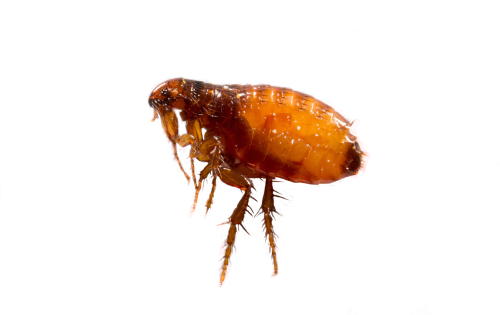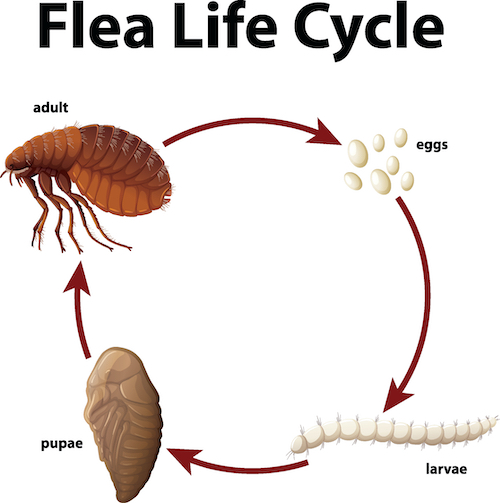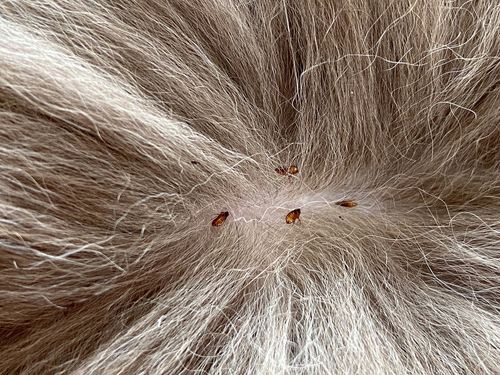What are fleas?

Fleas are blood sucking insects with compressed body shape that enables them to move through the furs of pets, and feed on their blood. They have six strong legs used for jumping and running; and they live most of their lives on the body of their animal host. The most common species of flea is the cat flea, Ctenocephalides felis, which is commonly found on dogs. Flea Bites Frequently Asked Questions? Read More…
Fleas survive best under warm weather, high humidity, and low altitudes. Before laying eggs, female fleas need to take a blood meal, while flea larva feeds on the reddish droppings of adult fleas called “flea dirt.”
What do fleas look like?

What do fleas look like? Fleas have different appearances in all stages of their lives, from larval to pupa and adult stage. Please see the illustration to the right for the lifecycle of the flea. The speed at which a flea matures is dependent on the environment and the time of year. The process can take weeks, months and eve years for a flea to completely develop into an adult.
What is the ideal temperature for fleas to survive?
Just like ticks, fleas thrive better in a warm environment. Their preferred temperature ranges from 70 to 80 degrees. They can also survive in warmer or cooler temperatures. Flea Bites Frequently Asked Questions? Read More…
How do fleas get into the home?
Fleas invade homes through three main ways; firstly, they may be remnants from previous infestations which weren’t properly contained; they may enter the house through your yard, and sometimes, your pet may bring them home after playing with other pets. Fleas, therefore, get reintroduced into the home even after flea treatment has been done. For this reason, it is necessary to re-treat both your pet and your home from time to time, to avoid a new infestation.
How do I find out if my pet has fleas?

Fleas are flat and reddish brown. They move very fast through the hair of their hosts, so to check if your pet has fleas, you’d need to examine the hair coat and fur of the animal under bright light. Also look out for flea dirt (flea faces), commonly between the shoulder blades of cats or above the rump of your dog. You can wipe the area with a wet white towel to check for flea dirt. Flea dirty turns reddish when wet. Flea Bites Frequently Asked Questions? Keep Reading…
Is scratching a sign my pet has fleas?
The fact that a pet doesn’t scratch isn’t enough proof that it is flea-free. Fleas do not live or all their life-cycle on a pet, so a pet may get infested any time as long as there are fleas in its environment. Pets scratch mainly when their skin is sensitive to flea bite- a condition called Flea Allergy Dermatitis. If the pet doesn’t have sensitive skin, it may not scratch even if it suffers from a major flea infestation.
Do fleas pose any threats to pets and humans?
Apart from making humans and pets uncomfortable, fleas also cause different kinds of illness in pets including hair loss, flea allergy dermatitis, and secondary skin irritations. Severe flea infestation of puppies and kittens can also cause anemia, which could result in the death of the young pet. Pets do not feel flea bites, but fleas leave salivary secretions which pets react to in different ways. This secretion causes scratching, rashes, inflammation, or secondary skin infection. Fleas also cause tapeworm in pets and children (when they mistakenly ingest fleas). Fleas also transmit bubonic plague among rodents, and from rodents to humans. Fleaborne Diseases of the United States
What is flea dirt?
Fleas dirt refers to flea feces. It is the tiny dark clump fleas excrete on your pet’s body. Flea dirt primary comprises of undigested blood. The presence of flea dirt on your pet is thus a clear sign of infestation.
What is Flea Allergy Dermatitis?
Flea Allergy Dermatitis (FAD) is an allergic reaction some pets suffer when fleas bite them, or when they come in contact with flea saliva. Flea saliva contains fifteen reactive components that cause the animal’s immune system to set up a hypersensitive defense, which gets triggered the next time the pet suffers a flea bite. This hypersensitive reaction manifests in the form of severe itching, which may not set off until the next time flea bites the pet, even if it takes a couple of months. This reaction then continues until the excessive scratching causes the pet to develop hive-like lesions all over its body, resulting in secondary skin infection.
Are fleas different from lice?
There are some differences between lice and fleas. They also share some similarities and they both have different effects on your pet.
Why does flea re-infestation occur every other year?
Flea re-infestation occurs mainly because of the fact that flea treatment and fumigation targets mostly adult flea. The eggs which lie around dormant may withstand flea treatment, and hatch to cause another round of infestation. Also, at the pupa stage, fleas can be resistant to most insecticides. They can lie dormant for several months, and when they develop into adult fleas, another round of flea infestation begins. The best way to avoid this is to continue flea treatment until all stages of flea in your home are eliminated. Here are some suggestions that can aid in effective flea control.
Fix a plastic sack to the vacuum clearer and vacuum-clean everywhere. Dispose of the bag with the entrapped contents carefully. This process can remove up to 50% of flea eggs lying around the home. Also, wash and treat your pets bedding every week with flea adulticides and growth regulators, so they don’t serve as a hideout for fleas and flea eggs.
Foggers are useful in treating open spaces inside the house. However, to reach pests that may be hiding under furniture and baseboards, you’d need to use surface spray.
Also, clean and treat your pet carrier, your car, garage, basement or any other place around your home where your pet spends some time.
Outdoor flea control involves cleaning the entire yard and kennel area. It is recommended that you use Eco-friendly fenvalerate containing sprays or sprays that contain IGRs. Also target moist, humid and warm areas, as these places are favorable for fleas to live in.
Flea treatment for pets?
There are different flea treatments you can use for your pet. You can bath your dog with our Flea & Tick Elimination Shampoo or use a flea dip in the case of severe infestation. You can also give your pet a monthly oral or topical preventative medication. In this case, topical preventative is always better because it helps clears the fleas before they can bite your pet. When giving your pet topical preventatives, make sure that you only bath them with mild shampoos, to avoid washing away the medication.
Cats are more delicate than dogs, so when giving your cat flea treatment, read all product labels carefully and ensure that you use only products meant for cats. Flea Halt Towelettes for cats are made with adulticides, while Biospots for Cats are made with IGR Nylar
Can I treat my cat with dog flea products?
Don’t do it! Dogs are generally stronger than cats hence dog flea treatments are made with very concentrated ingredients that cats’ skin may not be able to withstand. Topical flea treatment products contain ingredients like imidacloprid, fipronil, pyrethrins, and in the case of products exclusively meant for dogs, a higher concentration of pyrethrin called permethrin. Products labeled “Dogs Only,” generally contain a higher concentration of these ingredients, which may be harmful to a sensitive metabolism and body system of cats. Hence, it is even advised to keep cats away from dogs undergoing flea treatment with these products, as they can be life-threatening to cats. Flea Bites Frequently Asked Questions? Read More…
Can I give my pet an all-year-round flea treatment?
Although some southwestern states, most states below the Mason-Dixon Line and Hawaii, have some seasons when flea infestation becomes rampant- typically between seven to twelve months in the whole year. We strongly recommend monthly treatment of your pets with effective topical products like Advantage, Bio Spot and Frontline. Apart from eliminating flea at all stages, these products also serve as preventatives. You also need to treat your home and yard regularly (ideally every four to six weeks). For the midsection of the United States, flea infestation becomes very rapid between April and October. You can tackle this by treating your home and yard monthly during this flea season and treating your pet with both topical and oral flea prevention medications once every month.
In the northern part of the country, flea infestation happens less than six months a year. We recommend a monthly oral or topical flea preventive medication or the use of flea and tick collar. Pet owners should also treat their homes even in winter, as adult fleas do have a way of surviving in winter.
Should I wait before my pet gets fleas to start a flea treatment?
You can choose to wait for a confirmation before you start flea treatment, but you need to consider taking preventive measures for the following reasons.
Firstly, flea infestation is very difficult to contain because fleas always have a way of returning once they invade a place for the first time. It is also a costly and stressful process which will only make you wish you avoided it in the first place. Apart from being a nuisance, fleas also cause different kinds of infectious disease including tapeworm.
Also, fleas reproduce rapidly. Within three months, a pair of fleas can produce 20,000 newborn fleas! This means that it takes just a male and female flea to begin an infestation that can cause great discomfort to your pets and even you! We all love our pets and wouldn’t want them to go through the pain of being attacked by these blood-sucking pests, so prevention is always the best flea control measure.
What are the stages in a flea life cycle?
The flea life cycle involves four stages- egg, larva, pupa, and adult stage. After about two days of mating, female adult fleas lay non-sticky eggs which fall off from the pet’s body. The eggs hatch into larva within 2 to 6 days. Flea larva feeds on flea dirt around the environment, which is basically the mother’s feces. From there, they get a little blood for their nutrition. A cocoon starts forming around the larva within one week. The pupa stage is the stage where the larva has been completely encapsulated in the cocoon. It remains in this pupa stage for about two weeks. If environmental conditions aren’t favorable, fleas can remain in this pupa stage for up to one year, but under ideal conditions, fleas complete their life cycle from egg to adult within a month. Flea Bites Frequently Asked Questions? Read More…